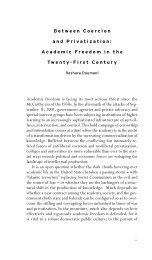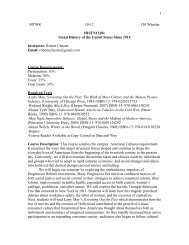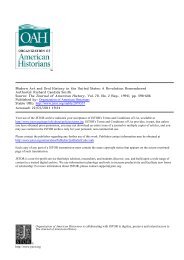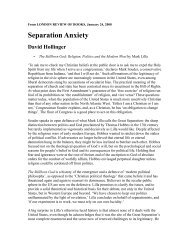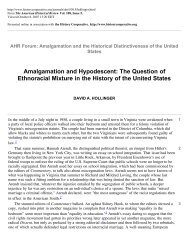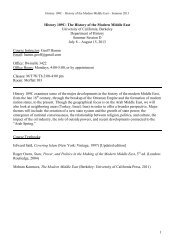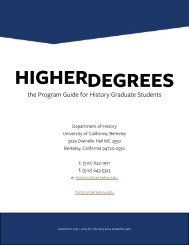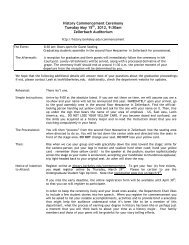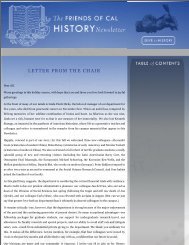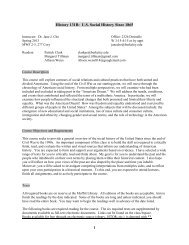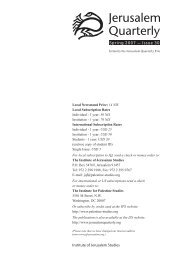Annual Newsletter 2007_Full.pdf - Department of History, UC Berkeley
Annual Newsletter 2007_Full.pdf - Department of History, UC Berkeley
Annual Newsletter 2007_Full.pdf - Department of History, UC Berkeley
You also want an ePaper? Increase the reach of your titles
YUMPU automatically turns print PDFs into web optimized ePapers that Google loves.
Friends <strong>of</strong> Cal <strong>History</strong> <strong>Annual</strong> <strong>Newsletter</strong> <strong>2007</strong>Greetings from the ChairContentsPr<strong>of</strong>essor Mary Elizabeth Berry reports on the <strong>Department</strong>'s activities this yearHomework by Our New Faculty"What I Did During My Summer Vacation," by Mark Peterson, Associate Pr<strong>of</strong>essor, Colonial American <strong>History</strong>"What I Did During My Summer Vacation," by Jonathan Sheehan, Associate Pr<strong>of</strong>essor, Early Modern European <strong>History</strong>"Relating to Britain," by Ethan Shagan, Associate Pr<strong>of</strong>essor, Early Modern European <strong>History</strong>Interview with Pr<strong>of</strong>essor Thomas W. LaqueurPr<strong>of</strong>essor Laqueur, Winner <strong>of</strong> the Mellon Foundation's Distinguished Achievement Award, responds to ten questions fromPr<strong>of</strong>essor Mary Elizabeth BerryIn Memoriam, Gerald D. FeldmanStaff Pr<strong>of</strong>ileVictor Rotenberg (Student Affairs Officer for Curriculum Planning) interviews Deborah Kerlegon (Assistant to the<strong>Department</strong> Chair)Faculty News & NotesNotes from the <strong>History</strong> Graduate Association<strong>History</strong> <strong>of</strong> Science graduate student Emily Hamilton reports on the <strong>History</strong> Graduate Association's activities during the fallsemester and the group's plans for the spring.Undergraduates in the FieldNotes from Phi Alpha ThetaUndergraduate student Stephanie Krol reports on the activites <strong>of</strong> the history honor society, Phi Alpha Theta.Recent Degree RecipientsPhD Job Placements
Donors to the <strong>Department</strong>Photo Gallery
Friends <strong>of</strong> Cal <strong>History</strong> <strong>Annual</strong> <strong>Newsletter</strong> <strong>2007</strong>Dear Friends,Greetings from the ChairWith this new electronic newsletter, I send you the warmest holiday greetings. All <strong>of</strong> us who have had a hand in this projecthope that you welcome the format, which allows us (among other things) to include a substantial photo gallery as well as avideo clip <strong>of</strong> Pr<strong>of</strong>essor John Efron playing blues guitar during a recent holiday party for the faculty and staff. John's wonderful(eye- and ear-opening) performance is now part <strong>of</strong> our collective e-memory. We also hope to add responses from readerson a periodic basis. Do send us by email (history@berkeley.edu) any notes you might like to contribute to the "Your Mail"section <strong>of</strong> the newsletter.The greatest blow <strong>of</strong> the year, as many <strong>of</strong> you know, was the loss <strong>of</strong> our beloved colleague Gerry Feldman on Octoberthirty-first. Gerry was at the core <strong>of</strong> our work and our strength since 1963, when he joined the faculty as an assistantpr<strong>of</strong>essor. We grieve with his family and lean every day on his legacies.Our lives have also been deeply changed by the retirement last spring <strong>of</strong> our colleague Leon Litwack after forty-three years<strong>of</strong> teaching at <strong>Berkeley</strong> (and more than a few studying here as well). A celebrated scholar and teacher (legendary for hissignature course 7B, U.S. <strong>History</strong> from the Civil War to the Present), Leon has added to armfuls <strong>of</strong> honors with his recentappointment as president <strong>of</strong> the Southern Historical Association and receipt <strong>of</strong> its highest tribute, the John Hope FranklinLifetime Achievement Award. We trust he has several lifetimes to go as an inspiration and tireless counselor to ourcommunity.You will find much more news about the faculty throughout this newsletter. Let me draw particular attention to theintroductions to our three newest members (Mark Peterson, Ethan Shagan, and Jonathan Sheehan) and to the interview withThomas Laqueur. Apparently Tom, too, is old and virtuous enough for a career award (which I prefer to regard as a midcareermarker). The Mellon Foundation has just granted him a (monumental) Distinguished Achievement Award. Theseawards provide "recipients and their institutions with resources for furthering scholarship and teaching. Amounting to as muchas 1.5 million dollars each over the course <strong>of</strong> three years, the awards also call attention to the role the humanities play inAmerican intellectual life."There is also great news on the graduate program front. Thanks to years <strong>of</strong> work by many peerless workers (preeminentlyPr<strong>of</strong>essor Mark Healey and Student Affairs Officer Barbara Hayashida), we launched with the admission <strong>of</strong> our currententering class a five-year funding plan for every new graduate student. This is possible because <strong>of</strong> significant new gifts,scrupulous husbanding <strong>of</strong> endowments, and the coordination <strong>of</strong> all projected resources. We are not entirely home free on thefinancial front. Nor are our five-year packages as generous as those <strong>of</strong> our wealthy private sisters. But through the enormoussupport <strong>of</strong> our splendid donors, we are definitely in the funding game.We have always been leaders in the intellectual enterprise. Our graduate students remain among the very best in thepr<strong>of</strong>ession. One clear indication is our continuingly high and distinguished record <strong>of</strong> placement. We awarded twenty-sixdoctoral degrees during the past year. And, as you will see, thirty-two <strong>of</strong> these and other recent Ph.D. recipients securedappointments since last December, twenty <strong>of</strong> them in tenure-track assistant pr<strong>of</strong>essorships. For other news on the activities<strong>of</strong> current graduate students, click to the section on the Graduate Student Association.You will also find descriptions by several <strong>of</strong> our undergraduates <strong>of</strong> the research trips they were able to undertake this year
with funds from our friends. The history major still is (we hope always will be) distinguished by the lauded (and sometimesterrifying) requirement <strong>of</strong> a senior thesis (<strong>History</strong> 101), which must be based on research in primary sources. Dozens <strong>of</strong> ourmajors travel every year to research sites to expand the sources and the experiences vital to original work. Here we <strong>of</strong>fer ataste <strong>of</strong> what they do. This section will expand considerably in future newsletters.Permit me to insert a word about daily life on the ground. I am delighted to mention that our departmental library (stockedwith titles relevant to the oral qualifying examinations) is now open all day everyday to graduate students (via key-card). Thisdevelopment falls in my own mind under "superior housekeeping," a group <strong>of</strong> initiatives spear-headed by our terrificManager, Linda Finch Hicks, and my extraordinary predecessor as chair, Pr<strong>of</strong>essor David Hollinger. Through (again) acombination <strong>of</strong> generous gifts and thoughtful stewardship, they have worked toward real environmental improvement--notjust library improvement but painting, carpeting, redesign, and excellent signage throughout our public spaces. We replacecomputers. We serve good food and reasonable drink at significant gatherings. We buy flowers. Nothing cushy. But many <strong>of</strong>us do feel a lift <strong>of</strong> spirit in spaces now better fitted to the dignified mission <strong>of</strong> the university. One person with a fastidious eyedaily on our physical arrangements is Deborah Kerlegon, Assistant to the Chair, who is pr<strong>of</strong>iled in this newsletter by theredoubtable Victor Rotenberg. I couldn't do my job without her.On the subject <strong>of</strong> physical space, I must shout with joy about the C.V. Starr East Asian Library, which was dedicated onOctober 12 and will be opened to the public this coming March. (Click "News and Events" on the departmental home pageto find an article about the library by Pr<strong>of</strong>essor David Johnson.) Many members <strong>of</strong> our department have worked for manyyears to make this dream real. The first purpose-built, free-standing building in the United States dedicated to an East Asiancollection, it is also a transforming space (especially inside) that just ennobles anyone who enters. The architects (ToddWilliams and Billie Tsien), the driving force (former Chancellor Chang-Lin Tien), the planners, the prescient donors--all havedone something magnificent.You will find a list <strong>of</strong> the many generous donors to the department this year later in this newsletter. To provide an occasion tothank and exchange further news with them, as well as all our friends and alumni, we have scheduled a cocktail reception atthe Women's Faculty Club between 5:30 and 7:30 on February 22. Tom Laqueur will give a talk (focusing on undergraduateeducation) and we expect to introduce some <strong>of</strong> our colleagues currently leading campus units. There are, as usual, quite a lot<strong>of</strong> them. Jon Gjerde is dean <strong>of</strong> the Division <strong>of</strong> Social Sciences, Carla Hesse is chair <strong>of</strong> the Budget Committee, CathrynCarson is Director <strong>of</strong> the Office for the <strong>History</strong> <strong>of</strong> Science and Technology, John Efron is director <strong>of</strong> the Institute forEuropean Studies, Yuri Slezkine is Chair <strong>of</strong> the Center for Slavic, East European, and Eurasian Studies, Wen-hsin Yeh isDirector <strong>of</strong> the Institute for East Asian Studies, and Peter Zinoman is chair <strong>of</strong> the Center for Southeast Asian Studies.Another reception will take place on Cal Day (April 12), following the now traditionalpanel <strong>of</strong> history faculty talking about "<strong>History</strong> in the Movies." We shall mail you notice<strong>of</strong> both events well in advance.I close with thanks to the people who have helped produce this newsletter--AndrewKeating above all (our Webmaster and a graduate student in British <strong>History</strong>),Stephanie Krol, Linda Finch Hicks, and Deborah Kerlegon.All warm regards,Beth Berry, Chair
Friends <strong>of</strong> Cal <strong>History</strong> <strong>Annual</strong> <strong>Newsletter</strong> <strong>2007</strong>Homework by Our New FacultyWe are delighted to welcome three new colleagues to the faculty. Mark Peterson (formerly on the faculty <strong>of</strong> the University <strong>of</strong>Iowa) joined us this fall, Ethan Shagan (formerly on the faculty at Northwestern) and Jonathan Sheehan (formerly on thefaculty <strong>of</strong> the University <strong>of</strong> Michigan) join us in the spring semester. We set them the beloved essay topic "What I Did duringMy Summer Vacation" as a framework for introducing themselves. Ethan bailed out and chose his own topic. We may dockhis grade."What I Did During My Summer Vacation,"by Mark Peterson, Associate Pr<strong>of</strong>essor, Colonial American <strong>History</strong>"Relating to Britain,"by Ethan Shagan, Associate Pr<strong>of</strong>essor, Early Modern European <strong>History</strong>"What I Did During My Summer Vacation,"by Jonathan Sheehan, Associate Pr<strong>of</strong>essor, Early Modern European <strong>History</strong>
Friends <strong>of</strong> Cal <strong>History</strong> <strong>Annual</strong> <strong>Newsletter</strong> <strong>2007</strong>What I Did During My Summer Vacationby Mark Peterson, Associate Pr<strong>of</strong>essor, Colonial American <strong>History</strong>When the historian's little gray cells get to feeling a bit overheated, I like to do manuallabor <strong>of</strong> one kind or another. Most days, at the very least, this means cooking dinner formy wife, Mary Woolsey, and our two children, Abby and Thomas, ages 14 and 11. Butsometimes I get more ambitious. Mary's family lives in Petersham, Massachusetts, in thewooded and hilly country about 75 miles west <strong>of</strong> Boston. Petersham is within strikingdistance <strong>of</strong> some major research archives for my work in early American history, but it'salso a peaceful and relaxing place to spend summer vacations.On one <strong>of</strong> these vacations, I lived out an unfulfilled childhood fantasy by building atreehouse -- for the kids, <strong>of</strong> course. I'm not particularly handy or skilled in carpentry, butwith the aid <strong>of</strong> a book called, "Treehouses You Can Actually Build," two semi-eagerchildren, and a barnful <strong>of</strong> old lumber, I managed to build the treehouse pictured here,nestled among the white pines typical <strong>of</strong> a southern New England second-growth forest.
That fall, when we returned to Iowa City, where I taught at the University <strong>of</strong> Iowa for a number <strong>of</strong> years, I felt compelled topractice and refine my newfound skills, this time in the 300-year-old black oak in our backyard. Here it is -- a somewhatdifferent style, with cross-hatched ropes instead <strong>of</strong> found wood to make the safety railings.Once I had run out <strong>of</strong> trees in need <strong>of</strong> development, I looked for a new outlet for my handiwork. A summer camp that mydaughter attended had a wood-burning beehive oven made out <strong>of</strong> stone, sand, and clay. I wanted to make one for ourbackyard, so I found another how-to book. The Iowa soil has plenty <strong>of</strong> clay, I scrounged broken paving stones fromneighbors, and used sand from the kids' sandbox (by then seldom used). I rounded up some friends from our Iowa Cityneighborhood, and we went at it on the weekend before Thanksgiving.
This story has no happy ending, at least not yet. Whether it was my inexperience at mixing clay and sand in the proper ratio,or the onset <strong>of</strong> Iowa winter, rain, and snow the following weekend, I don't know. But beehive-oven version 1.0 collapsedthe following spring, no bread was baked, no pizzas were made.However, one <strong>of</strong> the many benefits <strong>of</strong> moving to <strong>Berkeley</strong>, as I observeon the eve <strong>of</strong> my first Thanksgiving in California, is that the weather iswarm and sunny, and the backyard <strong>of</strong> our new house has lots <strong>of</strong> stonesand bricks for making ovens, and a number <strong>of</strong> trees calling out to me.Of course, I have plans to exercise the historian's little gray cells now thatI'm here -- in particular, a book on Boston in the Atlantic World has alsobeen calling out to me for some time. But there's always summervacation. The question is, when we finally get the boxes <strong>of</strong> booksunpacked, which will I find first, the treehouse guide, or the beehive ovenmanual?
Friends <strong>of</strong> Cal <strong>History</strong> <strong>Annual</strong> <strong>Newsletter</strong> <strong>2007</strong>Relating to BritainEthan Shagan, Associate Pr<strong>of</strong>essor, Early Modern European <strong>History</strong>I have always had a peculiar relationship with Britain, which makes me apeculiar sort <strong>of</strong> British historian. Most Americans who enter the field areunabashed anglophiles, ranging from rather mild cases, who only orderthe British editions <strong>of</strong> Harry Potter books, to potentially lethal cases,whose diagnostic signs include fondness for monarchy and ostentatioususe <strong>of</strong> words like "torch" and "lift." I cannot claim lifelong immunity; as achild I watched Monty Python and listened to Led Zeppelin. But Ithought my parents' obsession with "Upstairs, Downstairs" was unnatural,and I thought all the fuss about Charles and Diana (whose wedding I wasforced to watch at an obscenely early hour) was downright nauseating.So by the time I was a teenager, when my father got a job with a Britishcompany, I was temperamentally predisposed to find the country and itspeople otherworldly. This impression was reinforced by a harrowing evening in the port town <strong>of</strong> Holyhead as I backpackedthrough Wales, where I stayed at a Bed and Breakfast owned by a two-meter-tall transvestite (with three dogs namedCoco, Chanel, and Dior) who insisted upon driving me up into the hills to "see the lighthouse." It was reinforced again by myaccommodations when I first moved to London as an adult: my "flat" had a gas meter into which I had to feed coins to turnon the stove, and the house I moved into later was webbed with exposed electrical wires whose constant shocks wereevidently supposed to substitute for more conventional interior heating.Of course, my accumulated time living in Britain has s<strong>of</strong>tened my attitude considerably, and I adore spending time there now.However much I resented as a child being forced to watch Princess Diana's wedding, as an adult I went to Green Park towatch her casket pass by. And I have found that people in Britain, despite some occasional stereotypical reserve, are thekindest and warmest I have ever met. But as a historian, my early impressions still color my work, and I tend to gravitatetowards topics which challenge traditional understandings <strong>of</strong> British identity. Most recently, I am writing a book arguing thatthe stereotypical ideal <strong>of</strong> "moderation" in English society, which appears so inclusive and ecumenical, in fact has served as anaggressive polemical weapon and a tool <strong>of</strong> ideological violence in English history. In this project, as in my past work, I like tothink that my own fraught relationship with British culture enables me, at least in part, to avoid the trap <strong>of</strong> imagining Britishhistory as the progressive rise <strong>of</strong> modernity, and instead to see the British past as an alien land.
Friends <strong>of</strong> Cal <strong>History</strong> <strong>Annual</strong> <strong>Newsletter</strong> <strong>2007</strong>What I Did During My Summer VacationJonathan Sheehan, Associate Pr<strong>of</strong>essor, Early Modern European <strong>History</strong>I'd like to write about what I did last summer, but I'm not quite sure that Iremember yet. Memories <strong>of</strong> Maine oceans, Michigan rivers, and sunlitmeals with happy children float about in hazy disarray. But the hard drivewas nearly reset by the recent chaos <strong>of</strong> moving to <strong>Berkeley</strong>. Packing hasthat effect, I guess. The labor <strong>of</strong> categorizing the last ten percent <strong>of</strong> ahouse--the miscellaneous boxes <strong>of</strong> paper clips, snorkels, and sparechange--consumes so many mental watts that the rest <strong>of</strong> the circuits godead. Nor was winter ready for me to leave the Midwest, showing its irewith ice-drenched roads, freezing rain, and a final blizzard on DonnerPass. But the chains in the trunk <strong>of</strong> the car eventually won out, and lastThursday I tumbled into the Bay Area, heaved <strong>of</strong> a sigh <strong>of</strong> relief as the icemelted, and bade welcome to green and flowering hills. Home again, andnow perhaps those memories <strong>of</strong> summer can begin to thaw and return.
Friends <strong>of</strong> Cal <strong>History</strong> <strong>Annual</strong> <strong>Newsletter</strong> <strong>2007</strong>Interview with Pr<strong>of</strong>essor Thomas W. LaqueurPr<strong>of</strong>essor Thomas Laqueur has just been honored with The Andrew W. Mellon Foundation's Distinguished AchievementAward. We quote the Foundation: "Intended to underscore the decisive contributions the humanities make to the nation'sintellectual life, the awards, amounting to as much as $1.5 million each, honor scholars who have made significantcontributions to humanistic inquiry. They enable awardees to teach and do research under especially favorable conditionswhile enlarging opportunities for scholarship and teaching at the academic institutions with which the recipients are affiliated.The awards will provide the recipients and their institutions with resources to deepen and extend humanistic studies. Incontrast to other notable academic award programs that benefit individual scholars exclusively, the DistinguishedAchievement Awards are designed to recognize the interdependence <strong>of</strong> scholars and their institutions. Accordingly, while thisgrant program honors the achievements <strong>of</strong> individuals, the grants themselves will support specific institutional programs <strong>of</strong>activities that will enhance both research and teaching."Beth Berry seized this opportunity to ask Tom some questions.Berry: How is it that you decided to go to college at Swarthmore?Laqueur: Being completely uninformed on such matters, I was inclined to believe what I read. The Atlantic Monthly in thefall <strong>of</strong> 1962 published an article saying that Swarthmore was the best college in the United States. It was also near a city,unlike Beckley, W.Va.. I applied.Berry: I notice that your first book was about schooling, your next books were about sex, and your current project is aboutdeath. Any pattern here?Laqueur: What other subjects are there?Berry: What books are at the top <strong>of</strong> your lifelong favorites list?Laqueur: There are lots <strong>of</strong> books that have given me great pleasure and have changed my life. But no book or poemcontinues to touch my soul as some music has over the years: Schubert's C Major Quintet and the Opus 960 piano sonata;the Bach cello suites and St. Mathew Passion; Mozart and Wagner operas.Berry: What books do you think are seriously overrated?Laqueur: One <strong>of</strong> my best friends thinks George Eliot's Daniel Deronda is great. I can't get into it. Another <strong>of</strong> very bestfriends thinks Remembrance <strong>of</strong> Things Past is the key to all mythologies. I don't get it.Berry: What's the best thing we do at <strong>Berkeley</strong> for undergraduates?Laqueur: We talk to them as the serious, highly intelligent people they are even when they don't act the part. We performthe pleasure <strong>of</strong> the life <strong>of</strong> the mind.Berry: What's the worst thing we do for undergraduates?Laqueur: We don't take them as seriously as we should. We act bored.
Berry: What's the greatest reward <strong>of</strong> playing the cello every day?Laqueur: Hearing music from the bottom up; in my case from the cellar but slowly making my way to daylight. I have awonderful teacher and every so <strong>of</strong>ten he helps me to make beautiful sounds for a few minutes at a time. I hope for this everyday.Berry: What phrases dominate your conversations with your dog, Leo?Laqueur: I sometimes discuss my work with him. I try to encourage him by praising himas a "great dog," and not just a "good dog." Mostly I ask him to come and to desist fromeating paper: "Leo stop that!." He used to eat books, generally about the early modernperiod, but now he limits himself to scrap paper and cardboard, so I have become lessnegative in my conversations with him.Berry: As a Rosarian, what advice would you <strong>of</strong>fer the landscape architects <strong>of</strong> theuniversity?Laqueur: A good dressing <strong>of</strong> compost in the spring is important. I spray with an oilevery so <strong>of</strong>ten. I pick my roses <strong>of</strong>ten.Berry: As a distinguished achiever, how would you define achievement?Laqueur: I think there is a deep truth in Woody Allen's remark that showing up is 90% <strong>of</strong> success. Keeping faith with one'svocation during a lifetime <strong>of</strong> self-questioning is an achievement. It is an achievement to have enough confidence in one'sintellectual intuitions to pursue them where they lead. It is an achievement to have helped build a wonderful community <strong>of</strong>friends with and through whom I work.
Friends <strong>of</strong> Cal <strong>History</strong> <strong>Annual</strong> <strong>Newsletter</strong> <strong>2007</strong>Staff Pr<strong>of</strong>ileVictor Rotenberg (Student Affairs Officer for Curriculum Planning) interviews Deborah Kerlegon (Assistant to the<strong>Department</strong> Chair).I walked into the <strong>of</strong>fice <strong>of</strong> Deborah Kerlegon, the <strong>History</strong> <strong>Department</strong> staffer with the most campus seniority (not the mostdepartmental seniority -- that would be me), expecting mock-grudging cooperation: we'd been kidding around for weeksabout my interviewing her for the newsletter, and while I think she was secretly pleased to be featured in this issue, it wouldhave been entirely out <strong>of</strong> character for her to show it. But when I appeared in her door, she gave me a pained look."Guess what?" she said."What?" I said, displaying my customary quick wit and ready tongue."Can't do it," she said.I dropped my little pad and pen in faux shock."Why not?" I said."Too busy," she said, nodding her head at the stacks <strong>of</strong> paper on the spare desk along the side <strong>of</strong> her <strong>of</strong>fice.I suspected a ruse, but I do have to say this: when Deb's busy, she's really busy.I went back to my <strong>of</strong>fice and thought about it. Then I called her."<strong>Department</strong> <strong>of</strong> <strong>History</strong>, Chair's <strong>of</strong>fice," she said, sounding busy. (She's the Chair's Assistant)."How long have you worked on campus?" I said without preamble."29 years in June," she said."How long in the department?" I said."Since '92," she said."Where were you before you were here?" I said."Office <strong>of</strong> Relations with Schools," she said. "And before that, the Partnership Program.""Okay, I think that's it," I said, all business."You gonna tell 'em how they slave me and beat me?" she said."Gotta run," I said, and hung up.I went back later and filled in the holes.
VR: Who was your first boyfriend?DK: Wallace Walton, but he doesn't know it.VR: Who was your favorite teacher?DK: Donald Furnell. He had a great sense <strong>of</strong> humor, and spoke impeccable Spanish for an African American man. He was agreat motivator, too; way back then, in the 60s, he was encouraging us young African Americans to better ourselves througheducation.VR: What have you seen change on campus in the time you've been here?DK: There's so much less support for staff. We used to get regular cost-<strong>of</strong>-living increases as well as merit raises; nowadayswe think we're lucky to get little tiny merits. And as all these big non-academic units decentralize, we -- the staff out here inthe departments -- end up doing lots more work. So compared to 20 years ago, we're working much harder and gettingpaid less for it.VR: Nice hat you've got on today. How many do you have?DK: Around here, I feel like I wear about a hundred different hats. But if you mean how many real hats do I own -- about20.
Friends <strong>of</strong> Cal <strong>History</strong> <strong>Annual</strong> <strong>Newsletter</strong> <strong>2007</strong>Anthony AdamthwaiteFaculty News & NotesOn the lecture front the big one for me in fall 2006 was the commemoration <strong>of</strong> the seventieth anniversary <strong>of</strong> the outbreak <strong>of</strong>the Spanish Civil War. I gave a paper in Madrid on the internationalization <strong>of</strong> the conflict. Went back to Spain in <strong>2007</strong> - toPamplona this time - fortunately not for the "Sanfermines", otherwise I might not now be writing- but for an internationalconference at the University <strong>of</strong> Navarra on social change and modern identity. I discussed the relationship between war andidentity in twentieth century Europe. In October <strong>2007</strong> Opus Dei, a Roman Catholic community with a house in <strong>Berkeley</strong>,invited me to talk on "Hitler and Stalin: Twin Tyrants". Most recently, <strong>Berkeley</strong> Model United Nations (BMUN) asked me totalk on "The European dream v the American dream". Apart from the usual public lectures and conference papers, one <strong>of</strong> themost stimulating experiences over the past year or so has been working with a number <strong>of</strong> visiting scholars with interests in myfields <strong>of</strong> twentieth century Europe and international history. Equally rewarding in a different way has been the experience <strong>of</strong>mentoring several Decal classes. The enthusiasm for history and energy <strong>of</strong> undergraduate organizers and their students hasbeen a real inspiration.Thomas G. BarnesTom Barnes gave a series <strong>of</strong> three lectures on "Decisive Battles <strong>of</strong> the 18C: Fontenoy, Culloden, Quebec," to theAssociation <strong>of</strong> Emeriti in April; was gratified to receive a festschrift from his former students edited by Buchanan Sharp andMark Fissell, published by the Delaware University Press in January; sent <strong>of</strong>f to Stanford University Press his ownmanuscript, Shaping the Common Law: From Glanvill to Hale, 1188-1688, in October, and had a heart attack the same day(moral <strong>of</strong> the story: don't publish or you might perish).Andrew BarshayThis past year I finished my second term as graduate adviser for the department, and headed <strong>of</strong>f (temporarily) into the sunsetto return to work on my study <strong>of</strong> the collapse <strong>of</strong> the Japanese empire in northeast Asia. The part I'm writing now concernsthe internment in the Siberian gulag <strong>of</strong> more than 600,000 soldiers <strong>of</strong> the Kwantung Army--this was the main Japanese forcein Manchuria--who were put to hard labor and underwent reeducation along with millions <strong>of</strong> Soviets and other former AxisPOWs. Eventually I'll write the companion section on the dissolution <strong>of</strong> civilian colonial society. Put together, as they shouldbe, these stories really do take on the character <strong>of</strong> an epic, and make you think very hard about what it means to talk aboutany people's historical responsibility. I'd also like to mention that my 2004 book on Japanese social science appeared inJapanese translation this past spring.Mary Elizabeth BerryI spent the last year on the road, the first extended travel I've been able to undertake in twelve years. I was in New Delhi forone month, in Cambridge (UK ) for three, and in Kyoto for six. My research addressed the cultural and economic history <strong>of</strong>the seventeenth century in Japan with the question "Why Work So Hard?" But a lot <strong>of</strong> my time was given to play. In Kyoto Ilived on the left bank <strong>of</strong> the Takase River, looking out on cherry and willow and maple trees, looking down on herons andsnakes playing in the water. Thank to my daughters, I celebrated my sixtieth birthday at Kitcho in Arashiyama (which CraigClaiborne rightly called the best restaurant in the world). By the way, I kept a Kyoto diary for a month and would be happy
to send it to anyone interested. Just let me know (meberry@berkeley.edu).Thomas A. BradyI was the Heiko A. Oberman Visiting Pr<strong>of</strong>essor <strong>of</strong> Late Medieval and Reformation <strong>History</strong> at the University <strong>of</strong> Arizona forthe Fall semester and taught one graduate seminar. Life in the desert was interesting and exotic. Kathy and I are glad thatFINALLY in November it started cooling <strong>of</strong>f during the daytime hours. We returned to <strong>Berkeley</strong> in mid-December and I willteach Irish <strong>History</strong> in the Spring semester. This fall I gave a talk "The Stettmeister and the Teacher: There were two Sturmsat Strasbourg" at a conference in Strasbourg which gave us a chance to return to the city where 40 years ago I beganresearch in the archives. In late October at the Sixteenth Century Society and Conference in Minneapolis I was presentedwith a splendid two-volume Festschrift entitled "Politics and Reformations--Histories and Reformations--and Communities,Polities, Nations and Empires," edited by Christopher Ocker, Michael Printy, Peter Starenko and Peter WallaceMark BrilliantRichard Candida SmithAfter my first three wonderful, whirlwind, years as an assistant pr<strong>of</strong>essor,I received my first sabbatical semester in the fall <strong>of</strong> <strong>2007</strong>. During thattime, I poured myself into the final round <strong>of</strong> revisions for my forthcomingbook, tentatively entitled Color Lines: Racial Liberalism on America's"Racial Frontier," 1945-1975 (Oxford University Press, 2009). Prior tothen, in the spring <strong>of</strong> <strong>2007</strong>, I added a new course to my teaching rotation.That course, "Schooling America: Education in the United States inHistorical Perspective," grew out <strong>of</strong> a long-standing interest in the history<strong>of</strong> education which I acquired during four pre-graduate school years as ahigh school teacher in Brooklyn, New York.During the past year I finished the manuscript for a new book that the University <strong>of</strong> Pennsylvania Press will release in 2008.The title is THE 'THIRD SPACE': CALIFORNIA ARTISTS AND THE POLITICS OF IMAGINATION. The bookspans more than a century to examine factors that supported the broadening <strong>of</strong> the arts world to include a broader crosssection<strong>of</strong> the population. Sam Rodia, the builder <strong>of</strong> the Watts Towers; Jay DeFeo, one <strong>of</strong> the state's best-known abstractpainters; Noah Purifoy and Betye Saar, leader figures in the African American assemblage movement are among thosewhose careers and work are discussed. I have also been working closely with the San Francisco Museum <strong>of</strong> Art helping themuseum documents its history for its 75th anniversary coming up in 2010. This project had provided opportunities forstudents interested in the history <strong>of</strong> museums and cultural institutions to participate.Cathryn CarsonIn spring <strong>2007</strong> I finished <strong>of</strong>f two things. One is the manuscript for the Heisenberg book -- finally. It will be out next year fromCambridge University Press. The other is a year's worth <strong>of</strong> coursework in <strong>Berkeley</strong>'s nuclear engineering department. This isfor the second project I'm working on, on the history <strong>of</strong> the science behind nuclear waste management. Since then I've alsobeen to a bunch <strong>of</strong> nuclear waste research centers and archives in Germany, photographing documents at rates previouslyunseen. This fall I'm teaching a new course, "Nuclear <strong>Berkeley</strong>, Nuclear World" and working on a website on local nuclearhistory.Margaret Chowning
I have been on leave this year, finishing up research for a book tentatively titled: "Catholic Ladies and Culture Wars: Gender,the Church, and Mexican Politics, 1750-1940." I made several trips to Mexico City, Morelia, Guadalajara, Zamora, andCelaya using church archives, for the most part, to test my hypothesis that women's various relationships to the church--theirleadership <strong>of</strong> devotional associations, their role in religious education, their role as activist nuns--had an important impact onpolitics throughout this period.Thomas DandeletThe past year was marked by the publication <strong>of</strong> "Spain in Italy, 1500-1700," a volume that I co-edited with John Marino. Itbrings together nineteen essays by leading Italian, Spanish, German, French and American historians in the field, and includesmy essay entitled "Paying for St. Peter's." I was also invited to give a paper on the Colonna family, the present topic <strong>of</strong> myresearch, at a conference at the Spanish Academy in Rome this past May. In that same month, I traveled to New York toreceive a Guggenheim fellowship that I was awarded to continue work on the Colonna project.Jan de VriesJan de Vries returned this year to full-time teaching after serving seven years as Vice Provost for Academic Affairs. Hisbook, The Industrious Revolution: Consumer Behavior and the Household Economy, 1650 to the Present, is scheduled forpublication in April by Cambridge University Press.Beshara DoumaniBeshara Doumani is spending <strong>2007</strong>-2008 academic year as a fellow at the Radcliffe Institute for Advanced Studies, HarvardUniversity. He is working on a book on gender, law, and the political economy <strong>of</strong> family life in the Eastern Mediterraneanduring Ottoman times. His recent publications include the production <strong>of</strong> a special issue <strong>of</strong> the Jerusalem Quarterly, "SocialBiographies and Family Histories." and an article, "Palestine Versus the Palestinians? The Iron Laws and Ironies <strong>of</strong> a PeopleDenied," in the Journal <strong>of</strong> Palestine Studies.Paula FassAs a recipient <strong>of</strong> a John Simon Guggenheim Fellowship, Paula Fass was able to spend the last academic year at the Centerfor Advanced Study in the Behavioral Sciences. While there, she worked on her book on parents and children in Americanhistory since 1800 and led an international group <strong>of</strong> scholars in conversations on the history <strong>of</strong> children and youth. Her book<strong>of</strong> essays, Children <strong>of</strong> A New World: Society, Culture, and Globalization (New York University Press) was published earlierthis fall. Several <strong>of</strong> the essays that appear in the collection have appeared in journals published in Chile, France and Turkeyduring the past two years. She also made an appearance at an international symposium on public fears about children at theNew School in New York, which aims to bring scholars and the general public together to talk about subjects <strong>of</strong> generalconcern.Victoria FredeMy most exciting pedagogical experience in the academic year 2006-<strong>2007</strong> was a freshman seminar I taught on Heresy andBlasphemy in Modern Europe (including Russia): the charisma <strong>of</strong> <strong>Berkeley</strong>'s first-year students is impressive. I was alsodelighted by the inquisitiveness <strong>of</strong> students in my lecture survey <strong>of</strong> Imperial Russia. This academic year, I am on leave,finishing my book on atheism and other forms <strong>of</strong> unbelief among educated Russians in the nineteenth century. Next year, Ilook forward to teaching a course on Russian intellectual history.
Kathleen FrydlI spent fall <strong>of</strong> 2006 on leave in Washington DC working on my book; looking back, I have memories <strong>of</strong> a beautiful autumnreplete with long walks, relaxing dinners with friends, and enough time to get productive work done. I'm sure this is thenostalgic effect that a busy teaching schedule has on memories <strong>of</strong> sabbatical. Still, all <strong>of</strong> those things happened for at leastsome <strong>of</strong> the time I was away.When I returned to <strong>Berkeley</strong> in the spring <strong>of</strong> <strong>2007</strong>, I returned to the classroom. I lectured for the first time with amicrophone, something I will do again in spring <strong>of</strong> 2008 when I teach history 7b, the large lower division lecture taught formany years by Leon Litwack. Another first for me last spring: after my move to San Francisco in January <strong>of</strong> this year, I cameto campus via BART. I am now part <strong>of</strong> a small but energetic and growing band <strong>of</strong> <strong>Berkeley</strong> history faculty who live in SF.Like the others (I daresay), I am extremely satisfied with my life in the city, but <strong>of</strong> course campus and the halls <strong>of</strong> Dwinellecontinue to be another sort <strong>of</strong> home and, as it sometimes seems, my real residence.Samuel HaberI've thoroughly enjoyed teaching my Freshman/Sophomore Seminar, Concept & Image: Movies as Historical Documents forUnderstanding <strong>of</strong> United States' <strong>History</strong>, 1920-1945. The students are lively and some <strong>of</strong> the discussions have been exciting.I have continued my research in American Jewish history and have gone public with two articles for the just publishedEncyclopedia <strong>of</strong> American Jewish <strong>History</strong> (Stephen H. Norwood and Eunice Pollack, eds.). The first article is on HoraceKallen, the creator and advocate <strong>of</strong> the notion <strong>of</strong> cultural pluralism, and the second is a study <strong>of</strong> the thought <strong>of</strong> Robert KingMerton, the perpetrator <strong>of</strong> the new subdiscipline, the sociology <strong>of</strong> science.Roger HahnI helped plan, chaired and spoke at Humanities West's weekend program on Voltaire and the French Enlightenment lastOctober in San Francisco. My talk was focused on reconciling Voltaire's strong belief in religious toleration, even as hewrote and spoke against Judaism and Islam.David HenkinI have spent a fair amount this past year speaking about my book, The Postal Age: The Emergence <strong>of</strong> ModernCommunications in Nineteenth-Century America (Chicago, 2006), in a wide variety <strong>of</strong> venues -- at the <strong>Berkeley</strong> PostOffice, the American Philatelic Society, the National Postal Museum, various bookstores, a bar in the Mission District, onthe radio, and wherever else people have seemed disposed to listen. I also participated in a recent conference at NewsweekMagazine entitled "Bookishness: Reading and Writing After Print Culture."Carla HesseThis past year I taught two courses--a lecture course and a graduate seminar--both focused on the French Revolution. Thestudents in both courses were absolutely fantastic, I learned a huge amount from them, and they remind me every day justhow lucky and privileged I am to teach at <strong>Berkeley</strong>. Two undergraduates in the lecture course have become my researchassistants and they are helping me to finish my book about the infamous Revolutionary Tribunals and the problem <strong>of</strong> politicaljustice during the French Revolution. I also have a graduate student research assistant who is close to completion <strong>of</strong> a 10year project we have been working on with the Bancr<strong>of</strong>t Library, to catalogue and make accessible about 10,000 FrenchRevolutionary pamphlets. We have discovered that a significant number (in the 100s) <strong>of</strong> these pamphlets were previouslyunknown anywhere in the world--including at the Bibliothèque Nationale de France. Allez les ours! And, oh yes, vive la
République!David HollingerIn June I finished my term as Chair <strong>of</strong> the <strong>Department</strong> and am spending the <strong>2007</strong>-08 year on leave thanks to a fellowshipfrom the American Council <strong>of</strong> Learned Societies. During the past year I have presented papers at a number <strong>of</strong> scholarlyforums, and delivered keynote addresses at international conferences in Texas, Italy, and Norway. My most recentpublication is "Religious Ideas: Should they be Critically Engaged or Given a Pass?" in REPRESENTATIONS (January2008).Martin JayAmong the highlights <strong>of</strong> the past year were a number <strong>of</strong> invited lectures here and abroad: "Historical and AestheticExperience: A 21st-Century Constellation," <strong>History</strong> Dept, <strong>UC</strong>B, October, 2006; Conference on Contemporary ArtMuseums, Baeza, Spain, December, 2006; Conference on "Ahistoric Occasions," MASSMoCA, North Adams,Massachusetts, February, <strong>2007</strong>; California College <strong>of</strong> the Arts, San Francisco, April, <strong>2007</strong>; "Pseudology: Derrida on Arendton Lying in Politics," Institute for the Humanities, Temple University, October, 2006; Institute for the Humanities, SimonFraser University, Vancouver, Canada, November, 2006; "Scopic Regimes and the 21st-Century Museum," Conference on"Oltra Visualidad" Museum <strong>of</strong> Contemporary Art <strong>of</strong> Barcelona (MACBA), Spain, November, 2006; "The Virtues <strong>of</strong>Mendacity: On Lying in Politics," Faculty Research Lecture, <strong>UC</strong>B, February, <strong>2007</strong>; <strong>Berkeley</strong> Foundation, May, <strong>2007</strong>;University <strong>of</strong> Wroclaw, Poland, June, <strong>2007</strong>; Conference on 'The Politics <strong>of</strong> the Past'. Jyvaskyla, Finland, June, <strong>2007</strong>;European University <strong>of</strong> St. Petersburg, Russia, June, <strong>2007</strong>.I also published the following texts: "Taking on the Stigma <strong>of</strong> Inauthenticity: Adorno's Critique <strong>of</strong> Genuineness," New GermanCritique, 97 (Winter, 2006); and Theory as Variation, eds. R. Radharishnan et al. (Delhi, India, <strong>2007</strong>); "Ocularity," inSensorium: Embodied Experience, Technology, and Contemporary Art, ed., Caroline A. Jones (MIT Press, Cambridge,Mass. 2006); Reprint <strong>of</strong> "Cultural Relativism and the Visual Turn," in Images: A Reader, eds. Sunil Manghani, Arthur Piperand Jon Simons (Sage, London, 2006); Korean translation <strong>of</strong> "Must Justice Be Blind? The Challenges <strong>of</strong> Images to theLaw," in Bol, 4 (Seoul, Winter, 2006); Spanish translation <strong>of</strong> "Force Fields and Theorization <strong>of</strong> Intellectual <strong>History</strong>: A Replyto Fritz Ringer," Prismas, 10 (Quilmes, Argentina, 2006); "No State <strong>of</strong> Grace: Violence in the Garden," Sites Unseen:Landscape and Vision, eds. Dianne Harris and D. Fairchild Ruggles (Pittsburgh, <strong>2007</strong>); "1990: Straddling a Watershed?" (inRussian), New Literary Review (Moscow, Russia), spring, <strong>2007</strong>; Interview, European University <strong>Newsletter</strong> (St.Petersburg, Russia), June, <strong>2007</strong> Interview, Tygodnik Powszechny, Krakow, Poland, July 1, <strong>2007</strong>.David S. KeightleyI have virtually finished my latest book: "Working for His Majesty." I just have to find a publsher.Leon LitwackIn announcing to my colleagues that I planned to retire in May <strong>2007</strong> after forty three years at <strong>Berkeley</strong>, I told them, "I intendto continue lecturing (when invited), writing, and rockin'." I taught <strong>History</strong> 7B in the spring semester for the last time. That ishard to believe. The semester was memorable in many ways. I was presented the Golden Apple Award by <strong>UC</strong> <strong>Berkeley</strong>students (the only student-initiated teaching prize), and I was asked by the <strong>Department</strong> to give the commencement address inMay. It was, as usual, a very busy semester, giving a welcome address to incoming freshmen, meeting for dessert anddiscussion with students at the Clark Kerr campus (part <strong>of</strong> the Secret Lives <strong>of</strong> Pr<strong>of</strong>essors program), addressing the Regents'and Chancellor's Scholars luncheon, traveling to Park University, Missouri, to keynote the Midwest Phi Alpha Theta
Conference, meeting with the Golden Key Society chapter at <strong>UC</strong>, and speaking to the Regents and Chancellor's ScholarsAssociation (RCSA). In April, at the annual meeting <strong>of</strong> the Organization <strong>of</strong> American Historians in Minneapolis(commemorating its bicentennial) I participated in a panel, "The OAH and the Teaching <strong>of</strong> <strong>History</strong> in the Schools andColleges," and in the Plenary Session on "[OAH] Presidential Memories." I have also continued my work with high schoolteachers <strong>of</strong> history, speaking in the summer institute sponsored by the <strong>UC</strong> <strong>History</strong>-Social Science Project. During thesummer <strong>of</strong> <strong>2007</strong>, I spoke at Stanford to the annual session <strong>of</strong> The Junior Statesmen Summer School, in September I gavethe James Herndon Lecture at the San Francisco African American Historical and Cultural Society, and in November Ilectured at Kent State University and Oberlin College. In November I also attended the annual convention <strong>of</strong> the SouthernHistorical Association in Richmond, Virginia, where I was installed as the new president. I was also deeply honored to bedesignated by the SHA the first recipient <strong>of</strong> the John Hope Franklin Lifetime Achievement Award. (I first met Franklin as hisreader in a course in U.S. social history at <strong>UC</strong> in the summer <strong>of</strong> 1957.) I will be giving the presidential address in October2008 at the SHA meeting in New Orleans, and that should coincide with the publication <strong>of</strong> How Free is Free? The BlackStruggle from Jim Crow to the Present (Harvard Univ. Press), based on the Nathan Huggins lectures. I am now writing thethird volume <strong>of</strong> my trilogy on the African American experience in the South, Never Turn Back: The Black South and WorldWar II.Maureen MillerAfter spending the entire spring <strong>2007</strong> semester empanelled on a jury in the most boring civil case ever heard in the HaywardCounty Court House, I fled the country. Just in the nick <strong>of</strong> time, too, since the Vatican Library had announced that it wasclosing for three years, beginning July 15th, in order to undertake a major structural renovation <strong>of</strong> its palazzo. Undeterred byobvious cracks in the ceiling over our heads in the Sala di Manoscritti and by construction equipment already lurchingmenacingly in the courtyard, I and hundreds <strong>of</strong> other scholars enjoyed last glimpses <strong>of</strong> medieval manuscripts from theVatican's incomparable collections. For all that, it was really quite pleasant. I returned with excellent material on vestingprayers and began writing my book on clerical clothing in medieval Rome on a welcome leave supported by a fellowshipfrom the American Council <strong>of</strong> Learned Societies.Carlos NoreñaI have been on leave this last year, completing my book, The Circulation <strong>of</strong> Imperial Ideals in the Roman West, on the figure<strong>of</strong> the Roman emperor as a unifying symbol for the western Roman empire.Sheldon RothblattMy book on the controversies over merit selection, elitism and affirmative action appeared in January <strong>2007</strong> under the title"Education's Abiding Moral Dilemma: Merit and Worth in the Cross-Atlantic Democracies, 1800-2006." The countriesinvolved in the study are England, Scotland and the U.S. I will be giving the keynote address to a conference on privatizationin higher education to be held in January 2008 at the Technion, Haifa, Israel. I have also been invited to give the annual SirDouglas Robb Lectures at the University <strong>of</strong> Auckland in New Zealand in March 2008. The University is celebrating itsJubilee, and the subject <strong>of</strong> the lectures will be Clark Kerr, former president <strong>of</strong> the University <strong>of</strong> California who died at age 92in 2003.Raphael Sealeytwo scripts <strong>of</strong> mine were published in the first half <strong>of</strong> <strong>2007</strong>:1. an article: "Aristotle, Athenaion Politeia 57.4: Trial <strong>of</strong> Animals and Inanimate Objects for Homicide," in Classical Quarterly56 (2006)475-485,
2. a chapter: "Democratic Theory and Practice," in Loren J. Samons II, ed.: "The Cambridge Companion to the Age <strong>of</strong>Pericles," 238-257.Ethan ShaganBesides the not inconsiderable task <strong>of</strong> winning a job at <strong>UC</strong> <strong>Berkeley</strong> (hooray!), I published two scholarly articles in <strong>2007</strong>:"Protestant Radicalism and Political Thought in the Reign <strong>of</strong> Henry VIII" in the journal Past and Present, and "The TwoRepublics: Conflicting Views <strong>of</strong> Participatory Local Government in Early Tudor England" in an edited collection onrepublicanism in early modern England. In between diaper changes and episodes <strong>of</strong> Sesame Street, I also managed to givetalks in Oxford, Chicago, and Minnesota and occasionally work on my book.Yuri SlezkineI gave talks in Washington, Moscow, Jerusalem, and Nottingham (UK); took the Zhmerinka Express from Kiev toVinnytsia; failed to witness the filming <strong>of</strong> Taras Bulba in Kamianets-Podylskyi because one <strong>of</strong> the actors got drunk; translatedthe Russian translation <strong>of</strong> my first book back into Russian; and devoted the rest <strong>of</strong> my time to presiding over <strong>Berkeley</strong>'sInstitute <strong>of</strong> Slavic, East European, and Eurasian Studies.Randolph StarnI continue to find retirement heady work by laptop in <strong>Berkeley</strong> and on the road for talks, research, and editorial or awardscommittee assignments in New York, Turin, and Paris. In <strong>2007</strong> I published articles on Renaissance art and historiographyand, in connection with an ongoing project, "Authenticating the Past," on historical chronologies and museum history. Havingwritten about museums, I finally had my real-world apprenticeship as co-organizer (with the Open Society Archives <strong>of</strong> theCentral European University in Budapest) <strong>of</strong> a multinational, multimedia exhibition. The show on the explosion <strong>of</strong> interest inreal and imagined medieval pasts in post-Communist East Central Europe opened in November <strong>2007</strong> at the TownsendCenter for the Humanities, and plans are to have it travel to other venues in this country and abroad: see "The ContagiousMiddle Ages Comes to <strong>Berkeley</strong>".
Friends <strong>of</strong> Cal <strong>History</strong> <strong>Annual</strong> <strong>Newsletter</strong> <strong>2007</strong>Notes from the <strong>History</strong> Graduate Association<strong>History</strong> <strong>of</strong> Science graduate student Emily Hamilton reports on the <strong>History</strong> Graduate Association's activities during the fallsemester and the group's plans for the spring.This year, the <strong>History</strong> Graduate Association is running a number <strong>of</strong> new programs for the graduate community, as well ashistory undergraduates and faculty and staff <strong>of</strong> the <strong>History</strong> <strong>Department</strong>. The HGA has instituted a series <strong>of</strong> panel colloquia onmethodology and historical focus, with an aim <strong>of</strong> <strong>of</strong>fering students a forum to discuss current trends in the field with interestedfaculty. The first in the series, a panel titled "Going Global: The world history perspective" was led by pr<strong>of</strong>essors Alan Karrasand Mark Healey. This panel was a resounding success, and set the stage for the next three panels <strong>of</strong> the semester, all <strong>of</strong>which enjoyed a great turnout and a stimulating question-and-answer period following the presentations. These panels were"Talking <strong>History</strong>: Working with oral histories" (Richard Cándida Smith and Vic Geraci); "Building on the Past: What is urbanhistory" (David Henkin and Robin Einhorn); "Rethinking the Past: New perspectives in history" (James Vernon and PaulaFass.) To follow this programming, the HGA is excited to announce a dissertation colloquia series planned for the spring, inwhich advanced graduate students will present their original research, writing strategies, funding resources, and other topicsrelated to the dissertation stage.The HGA is also hosting a number <strong>of</strong> social events throughout the year to create a greater sense <strong>of</strong> community among thedepartment's graduate students. We have had great success so far with our first events. To kick <strong>of</strong>f the year, the HGAhosted the Welcome Reception for faculty, staff, graduate students, and friends <strong>of</strong> the <strong>History</strong> <strong>Department</strong>. This first evendrew a large crowd and, with the help <strong>of</strong> the faculty, new events were implemented into the program to help our expansivecommunity get to know one another. The <strong>Department</strong> also sponsored a number <strong>of</strong> different prizes, including books, giftcertificates, and the wildly popular "Lunch with a Pr<strong>of</strong>essor." Following this, the HGA had great turnouts at the First YearBarbeque and a Cal Bears kick-<strong>of</strong>f party, as well as a number <strong>of</strong> informal gatherings for graduate students that were heldthroughout the semester as an opportunity for socializing, relaxing, and enjoying a bite to eat. The spring semester promisesto hold more events, including the much anticipated return <strong>of</strong> the Historians' Classic Basketball Game between students andfaculty.The members <strong>of</strong> this year's HGA are Jon Cole, Emily Hamilton, Hannah Murphy, Sam Redman, Jeff Wolf, and Phil Wolgin.Many events are open to alumni. Please feel free to contact any <strong>of</strong> the members for more information.
Friends <strong>of</strong> Cal <strong>History</strong> <strong>Annual</strong> <strong>Newsletter</strong> <strong>2007</strong>Undergrads in the FieldThe following students were among many who undertook research travel, supported by the Friends <strong>of</strong> Cal <strong>History</strong>, whilepreparing their theses as history majors.Scott AltoRecognizing the absence <strong>of</strong> comprehensive histories concerning California's role in the American Civil War, I decided towrite my thesis on what happened in California during the war. I wrote about the state's volunteer troops to argue thatCalifornia was vital to the Union war effort. My thesis discusses the constant fear <strong>of</strong> attacks that would disrupt thetransportation <strong>of</strong> gold and silver to the East and the multiple wartime activities <strong>of</strong> California soldiers (including limited action inthe East and the occupation <strong>of</strong> Arizona and New Mexico after a Confederate invasion <strong>of</strong> the territory). One <strong>of</strong> the mostinteresting subjects <strong>of</strong> my thesis was an early War <strong>Department</strong> plan to invade Texas via Mexico using California troops. Theplan was scrapped due to the Confederate invasion <strong>of</strong> New Mexico.I was very fortunate to have the funds from the <strong>Department</strong>'s travel program. The funds allowed me to meet with experts inChico and to make several visits to Sacramento to visit the California State Military Museum and the state's archives. Thesetrips made my thesis stronger. I hope to keep working on the topic (even though I have turned in my thesis) so that a gap inCalifornia's history can filled.Joseph BoertieMy research looked at the military and civil defense measures taken between the years 1939 to 1974 in the San FranciscoBay Area. Instead <strong>of</strong> dealing with the pleasantries <strong>of</strong> civility normally focused on between nations, my research went into themeasures the United States undertook in reaction to hostile relationships with foreign countries. As the twentieth centurywore on, the United States' global military responsibilities grew and consequently ever more dangerous enemy threatscoalesced, and so the nation needed to develop protective efforts to negate the dangers <strong>of</strong> foreign attack. The massivedefensive expansion from slit trenches to ward <strong>of</strong>f invasion assaults in the 1940's and into the Nike missiles, which couldshoot down ICBMs, shows the range <strong>of</strong> defenses employed. However, though the defensive weaponry and militaryoperations manifested into a highly technological state <strong>of</strong> readiness, their eventual obsolescence has left most bunkers andoutposts in disrepair around the Bay Area. We live in an age where there is little defense against a determined enemy. Theremnants <strong>of</strong> previous endeavors for national defense are all around the San Francisco Bay Area and can be visited by thesmallest toddler. Since the dissolution <strong>of</strong> the Nike missile system in 1974, the United States has not had a viable defensivemeasure against nuclear annihilation. Though my paper does not go into future policy, I believe it ends questioning the futuredefensive viability that can be measured strictly by concrete and the diameter <strong>of</strong> a gun barrel.I was able to conduct a good deal <strong>of</strong> my research on campus, using the Ethnic Studies Library, Environmental DesignLibrary, Main Stacks, M<strong>of</strong>fitt Library, and Bancr<strong>of</strong>t Archives. With the opportunity afforded by the research grant, I tookmy paper further by visiting the one Nike missile sit remaining in the Bay Area, talking with the rangers and looking throughthe missile magazine underground. Also, the details required by my paper spurred me to conduct research at the PresidioArchives. Without the research grant, it would have been extremely difficult to make my paper the way I wanted it to turnout.
Brianna BrickerAfter studying the ancient Mediterranean since freshman year, Iwrote my 103 seminar research paper on the Parthenon, butsubmitted it feeling entirely unqualified to write on the timelesstemple without ever having seen it. For my 101 thesis I turned againto this monument, but this time with new questions and as acomparison to its archaic predecessor. My trip to Athens wasinvaluable for my thesis, as it allowed me to conduct originalresearch and rely less on modern scholars. I spent four days battlingschool crowds and tour groups in museums and on archaeologicalsites for a firsthand look at contemporary iconography, gaining abetter understanding <strong>of</strong> spatial aspects in the process. Despite theswarms and scaffolding, my time on the Acropolis allowed me totrace the sacred route <strong>of</strong> the ancient Athenians and view the marble masterpieces as they would have, getting more into theirmindset than any book would allow. Two layovers later and in need <strong>of</strong> much sleep, I arrived back home confident and moreinspired than ever to work on my thesis and apply what I had absorbed during my stay.Libby KennedyWhen I enrolled in my <strong>History</strong> 101 class, I knew that I wanted to research Argentina's relationship with the military and itsmemory <strong>of</strong> the dictatorship (1976-1983) during democracy. During the year that I studied in Buenos Aires this was a topicthat I found fascinating because it seemed to be constantly present despite the fact that the dictatorship had ended overtwenty years ago. I contemplated different ways in which I could research this difficult topic and I decided to look intocomics. I love the humor genre because it is so particular to the time and place in which it was created. Thus, I specificallychose to look at the representations <strong>of</strong> the military found in comics during the post-dictatorship period. I also limited myscope to newspaper comics because these provided an immediate response and interpretation <strong>of</strong> the events <strong>of</strong> thesetumultuous years. After researching which libraries had the newspapers I needed, I originally thought I would have to go toAustin, Texas. However, on a whim I went with a group <strong>of</strong> students to Stanford and discovered that the Hoover Institute hadjust received a collection <strong>of</strong> Argentine newspapers on micr<strong>of</strong>ilm which were yet to be catalogued. While the collection wasspotty, it did have most <strong>of</strong> the dates that I needed to complete my research. So, for the next few weeks I would make myway to Stanford—a trip that most <strong>of</strong> us undergraduate researchers are all too familiar with! And the comics did notdisappoint: ridiculous and biting in their commentary, they gave me insight into the ways in which Argentine humor hasgrappled with the legacy <strong>of</strong> the military.Linda NybergSeptember and October were especially hot this year. The sun bore down from a cloudless sky, mocking me as the DD280series found a new home on my bedroom floor, away from the sleek Main Library shelves. I had started with a simple ideaananalysis <strong>of</strong> October 7, 1964, one relatively normal day in East Berlin-but it soon evaporated in the heat. Instead <strong>of</strong>examining one day, I would study time itself.But time is a slippery subject, one that has vexed philosophers, anthropologists, sociologists, and psychologists alike. Andhistorians, though their craft is based in particular understanding <strong>of</strong> time, have generally shied away from its discussion. Madeaware <strong>of</strong> the existence <strong>of</strong> a <strong>History</strong> <strong>Department</strong> travel grant just two days before the deadline, I knew I had to apply. Iwould need to go to great lengths to study the experience <strong>of</strong> time in East Germany; I would have to go to Berlin.And thanks to the travel grant, I could. On October 10, I left sunny <strong>Berkeley</strong> for a cloudy, 40-degree Berlin. Unfortunately,
several <strong>of</strong> the interviews I had planned came to naught, although I did have the opportunity to interview former East Germancitizen Irmtraut Petersson, whose experiences I made extensive use <strong>of</strong> in my thesis. Also valuable was my visit to theDeutsches Rundfunkarchiv (Archive <strong>of</strong> German Broadcasting or DRA) in Potsdam, where I watched footage from EastGerman anniversary celebrations with the helpful support <strong>of</strong> DRA historians. Upon my return to <strong>Berkeley</strong> on October 15, theoppressive sun had given way to a comforting drizzle. I was ready to write.
pFriends <strong>of</strong> Cal <strong>History</strong> <strong>Annual</strong> <strong>Newsletter</strong> <strong>2007</strong>Notes from Phi Alpha ThetaUndergraduate student Stephanie Krol reports on the activites <strong>of</strong> the history honor society, Phi Alpha Theta.Phi Alpha Theta (PHAT) is the University <strong>of</strong> California-<strong>Berkeley</strong>'s undergraduate history honor society. The primary goal <strong>of</strong>PHAT is to provide a means for history students to come together in a variety <strong>of</strong> academic, scholarly, and social settings.PHAT organizes many events during both the Spring and Fall Semesters. Many <strong>of</strong> the popular functions the organization putstogether include: visits from guest lecturers (<strong>of</strong>ten history department faculty) discussing various topics and historicalconcepts, a student-faculty dinner that gives undergraduates a chance to meet their pr<strong>of</strong>essors outside <strong>of</strong> the classroom, andan upcoming "101 Circus" that will allow students to present the topics <strong>of</strong> their history honor theses to fellow students andfaculty. Overall, PHAT attempts to enrich the experience <strong>of</strong> all history students by helping to enhance interaction betweenundergraduates and the history department's larger academic community. Take a look at some pictures from our latestevents!
Friends <strong>of</strong> Cal <strong>History</strong> <strong>Annual</strong> <strong>Newsletter</strong> <strong>2007</strong>Fall 2006Master <strong>of</strong> ArtsRachel Deborah BernardAlejandra DubcovskyMelisa Catarina GalvanStephen Gerard GrossDaniel MellenoDoctor <strong>of</strong> PhilosophyJason Randolph AmbroiseLauren Ashley AraizaWinson W ChuKavita Saraswathi DatlaRuben FloresAaron Charles FreundschuhKristin L HuffineEric Gregory KlockoKaren Ann Mc NeillNita Verma PrasadMelissa Mary PtacekTimothy Francis RoseGerard Henry SasgesDavid Andrew Michael SpaffordKathleen Anne StewartSpring <strong>2007</strong>Master <strong>of</strong> ArtsHelaine Debra BlumenthalBrandon Scott CohenAfshin DarianDesmond Fitz-GibbonJed Shaver-Rivera FolandMichael Andrew GonzalesBlake Spenser JohnsonAndrew Prescott KeatingRecent Degree Recipients
Filippo MarsiliMackenzie Katherine Lee MooreMiriam Beth NeirickKnightcarl RaymondAriel RonLena SalaymehJulian Thiesfeldt SaltmanDoctor <strong>of</strong> PhilosophyThabiti A AsukileStephen Christopher BrainCorrie Ruth DeckerEydoxios DoxiadisAmy Aisen ElouafiJacqueline Lee FriedlanderMichelle Tien KingJoyce MaoMiriam Beth NeirickMary Clay OshatzCharity Leah Urbanski
Friends <strong>of</strong> Cal <strong>History</strong> <strong>Annual</strong> <strong>Newsletter</strong> <strong>2007</strong>Recent Job PlacementsName Field Job ObtainedChristopher L. Agee United States U Colorado - DenverAmy Aisen Middle East Syracuse University*Stephen Brain Late Modern Europe Mississippi State University*Jennifer Burns United States F07Postdoc Hoover Inst (Stanford) F08 Univ <strong>of</strong> Virginia*Winson Chu Late Modern Europe U Wisconsin - Milwaukee*Corrie Decker Africa Lehman College*Evdoxios Doxiadis Late Modern Europe Postdoc PrincetonLouise Nelson Dyble United States U Southern California, Assc Dir Research, Keston Inst.Andrea S. Goldman East Asia China Univ. <strong>of</strong> Maryland College Park*John Holmes Late Modern Europe San Francisco State UniversitySarah Jackson United States Colorado U - Boulder, Ctr Amer.West-Fac Res AssocAndrew Jewett United States Harvard University*Lisa Kaborycha Early Modern Europe Postdoc 3y Medici Archive Project (Florence, Italy)Eric Klocko United States Monterey Peninsula College (Librarian)James Krapfl Late Modern Europe McGill University*Seung-Joon Lee East Asia China Singapore University*Joyce Mao United States Northern Kentucky University*Dalia Muller Latin America Loyola Marymount (L.A.)*Miriam Neirick Early Modern Europe Cal State Univ-Northridge*Molly Oshatz United States Florida State U*Lubna Qureshi United States Postdoc Northwestern UShakhar Rahav East Asia China University <strong>of</strong> Haifa*Padraig Riley United States Postdoc NY Historical Society & New School lecturerDon Romesburg United States Sonoma State University (Lect) Women's StudiesGerard Sasges Late Modern Europe Ohio University*Kevin M. Schultz United States U Illinois - Chicago*William Scott United States University <strong>of</strong> DelawareDavid Spafford East Asia Japan University <strong>of</strong> Washington*Justin Suran United States Modesto CollegeDeborah H. Yalen Late Modern Europe F07 postdoc U Michigan; F08 Colorado St. U-Fort Collins** denotes tenure track position
Friends <strong>of</strong> Cal <strong>History</strong> <strong>Annual</strong> <strong>Newsletter</strong> <strong>2007</strong>DonorsAll <strong>of</strong> us in the department are enormously grateful to the people and organizations listed below for generous gifts during thepast year. We couldn't do without you.Please note that we have included in a separate list the donors to the Frederic E. Wakeman, Jr. Graduate Student SupportFund. Their gifts honor a beloved colleague and monumental scholar who died on September 14, 2006. We shall long mournhim.We urge all within our extended circle to consider tax-deductible contributions to the department <strong>of</strong> any amount. They areused overwhelmingly for the support <strong>of</strong> undergraduate and graduate research, though may be directed by donors to otherspecific purposes. Donors may make contributions via the Web (click the box "Give to <strong>History</strong>" on the left side <strong>of</strong> mostdepartment web pages) or by mail (please make out checks to the Regents <strong>of</strong> <strong>UC</strong> and send them to the <strong>Department</strong> <strong>of</strong><strong>History</strong>, University <strong>of</strong> California, <strong>Berkeley</strong> CA 94720-2550).Major GiftsAnonymousThe Leonard Pearlman FundBarbara & Thomas R. MetcalfJoan P. & Malcolm Cochrane RossDoris G. Quinn FoundationSilicon Valley Community FoundationFrederic E. WakemanUp to $10,000AnonymousPaul ClarkBeatriz & Peter Mark EsparzaBeth L. Kelly & Roy Steven GeigerCarol Diane SocFrances and Randolph StarnErik Michael & Pamela Ryan SternbergUp to $1,000Stephen H. AbelCarol Lee AllenElizabeth C. & Peter Joseph AltieriJudith L. AndersonMargaret L. Anderson & James J. SheehanMilton C. Axt
Jane Ellyn & Lawrence J. BaackJeanne-Marie D. & Thomas G. BarnesAndrew E. BarshayLewis BatemanHarry & Jane N. BauerJules BeckerVictoria Christina BelcoSusan Benson & Peter ImperialPeter Eduard & Sophia E. BergmannDavid BerkeJoAnn T. & Ronald C. BerridgeMary Elizabeth BerryAl BoruiceClinton Neave BowellKatherine G. & Thomas A. BradyJoanne Dane BrodkeAmelia BrownIrene N. & Jerome F. BrownJohn Taylor BrowningGene A. & Marion BruckerMalcolm H. & Susan G. BurnettRichard Curtis BurnettPamela Joan BurnsCynthia ButlerRichard F. & Mary C. D. CarterRafael CastenadaKong Hung & Pik-Chong Agnes W. ChanLeonard G. & Marie B. CollinsMarianne C. ConstantinonJonathan Wilson CosbyMaria & Philip Fillmore CrabbeCindy CretanNancy Hayden CrowleyAnthony CrudeleEleanor & Nick CrumpJohn Stephen CumminsRegina Defalco-Lippert & Alexander LippertJim & Sally Chamberlin DewittCharles B. & Leslie Burke DickePatricia N. & Peter M. DinkelspielIrina Geliov & Stephan Brian DoliovMary Pauline DolvenEdgar L. & Emmy Fitzmaurice DowDenise Yvonne EbrightWilliam J. EdickHenry David FetterMichelle Marie Fontaine
Virgina Hamerslag FriedmanSara Layport GermainJon A. & Ruth Ann GjerdeElisabeth G. & Ken Bell GleasonSamuel Esau GoldmanWilliam Mark GoldmanRosanne GoodwinMartin LivingstonKenneth James & Vera Low HaganJill Lerner HallinanKaren P. & Kenneth Roy HarleyKevin Francis HarringtonStuart H. HellmanRobert HoldenDavid A. & Joan Heifitz HollingerKaren S. & Robert HoltermanWilliam M. HowellJean Arthur & Robert P. HustonAyako Ichihara-BoswellMichael Bonner InmanLaura Gambs IrvinJohn T. & Martha Hamilton JonesDeborah Kahane-RegoGary Leon & Ilene Sakheim KatzDavid N. & Vannie T. KeightleyJohn Alan KingNancy M. KleinKathleen KookCharles KormanKlonie Morris KunzelSita & Watson McMillan LaetschDavid Clay LargeKristi LarsenJane Mary LeroeJanet Barbara LeventhalPatricia Marie LewisJeanne St. Hill & Peter C. LeyAlison Klarimont & William M. LingoRobert Donald MacklerNatalie Beth MacrisRachel Dawne MarzionE. Thomas & Mary C. McCarthyGregory F. & Julia Justus McGinityNancy E. & William A. McKeeHelen M. MickiewiczMaureen C. MillerMillstein & Associates
Miroslava JakovljevichDavid KettnerGeorge Eagleton MooreRichard B. MorganJoe William & Mary L. MorgantiPeter Salvador MunozJessica Ruth NatkinKathryn Marie NeriJosh NicholJames Michael O'KeefeMatthew Wallace O'ReillyCharlene O'RourkeStephen John OsborneJohn W. PattonSusan Gillett & Terry M. PetersonHoai Nguyen & Julie PhamLinda Seltzer & M. L. Pop<strong>of</strong>skyCydney Sharon PosnerTherese PowellJohn Daniel RegoGweneth Bourgeault & Roderick Carl RehnborgWilliam Charles ReuterGlenn Matthew RichardEdith C. & Kenneth RiemerMichael A. RobardsEugene W. & Linda Post RosowChristopher Scott & ErendiraElizabeth Ann RubinMarcy Ryan-NicholLaura Blanche SackPriya SatiaDwight Frederick & Robin M. ScottPaul ScottBetty Sue & Thomas A. SeatonMario SeiditaDarril SmithJanet M. SmithConstance Brooke SommerJoshua Adam SpeyerLa Vada F. & Virgil Clinton StaffKenneth Milton StamppFrances & Randolph StarnChinami S. & Peter J. SternThomas SwiftAlan TamRhys Clifford ThomasDavid William & Wendy E. Tollen
Perrin TowersJohn Vincent TozerAndrew VillaCynthia Ann VogelTodd Alan WeinmanAnthony J. & Siv Larson WheelerSam Jackson WhitingAnette M. & Fred WilkinsonEdwin F. & Frances WinbergRichard H. & Sharon M. WiseKen WittEva Shetacek & Richard C. WolfSue Oy WongAmy Rein & Thomas B. WorthEiji & Kahori YutaniFrederic E. Wakeman, Jr. Graduate Student Support FundMargaret L. Anderson & James J. SheehanAnonymousJeanne-Marie D. & Thomas G. BarnesMary Elizabeth BerryBeverly BouwsmaDavid D. & Diane M. BuckStephen F. CohenBenjamin A. & Sarah S. ElmanJoseph Wharton EsherickMarie-Claire FeugeasDouglas Lane & Hsiao-Teh FixJon GjerdeQitao GuoCharles W. HayfordDavid A. & Joan Heifetz HollingerChen-Mo & Hsiao-Ping HsuJewish Community Endowment FundDavid N. KeightleyJudith Metzger & Stanley B. LubmanMelissa Ann MacauleySteven MandelbergJingZhu MaoEugenio MenegonKenneth Ronald MosternSusan NaquinDwight H. & Julie Rate PerkinsAllison RottmannRobert A. ScalapinoIrwin Scheiner
Yuri SlezkineJonathan D. SpenceAnna Xiao Dong SunJanet Mary TheissEzra F. VogelFrederic Evans & Sally S. WakemanQingcheng WangTimothy Bergmann WestonTatsuo YamadaWa YeMarcia Ann YonemotoWang YuanhuaMadeline H. ZelinWe deeply apologize for errors. Please contact history@berkeley.edu with any corrections.
Friends <strong>of</strong> Cal <strong>History</strong> <strong>Annual</strong> <strong>Newsletter</strong> <strong>2007</strong>Photo GalleryCommencement <strong>2007</strong><strong>Berkeley</strong> Stanford Colloquium (November 7, <strong>2007</strong>)Phi Alpha Theta DinnerHoliday Party (December 13, <strong>2007</strong>)<strong>History</strong> 101 Colloquium (May, 2008)Commencement 2008
Friends <strong>of</strong> Cal <strong>History</strong> <strong>Annual</strong> <strong>Newsletter</strong> <strong>2007</strong>Photo GalleryPhi Alpha Theta Dinner
Friends <strong>of</strong> Cal <strong>History</strong> <strong>Annual</strong> <strong>Newsletter</strong> <strong>2007</strong>Photo (and Movie) GalleryHoliday Party (December 13, <strong>2007</strong>)View a movie <strong>of</strong> Pr<strong>of</strong>essor John Efron's musical performance at the party!



